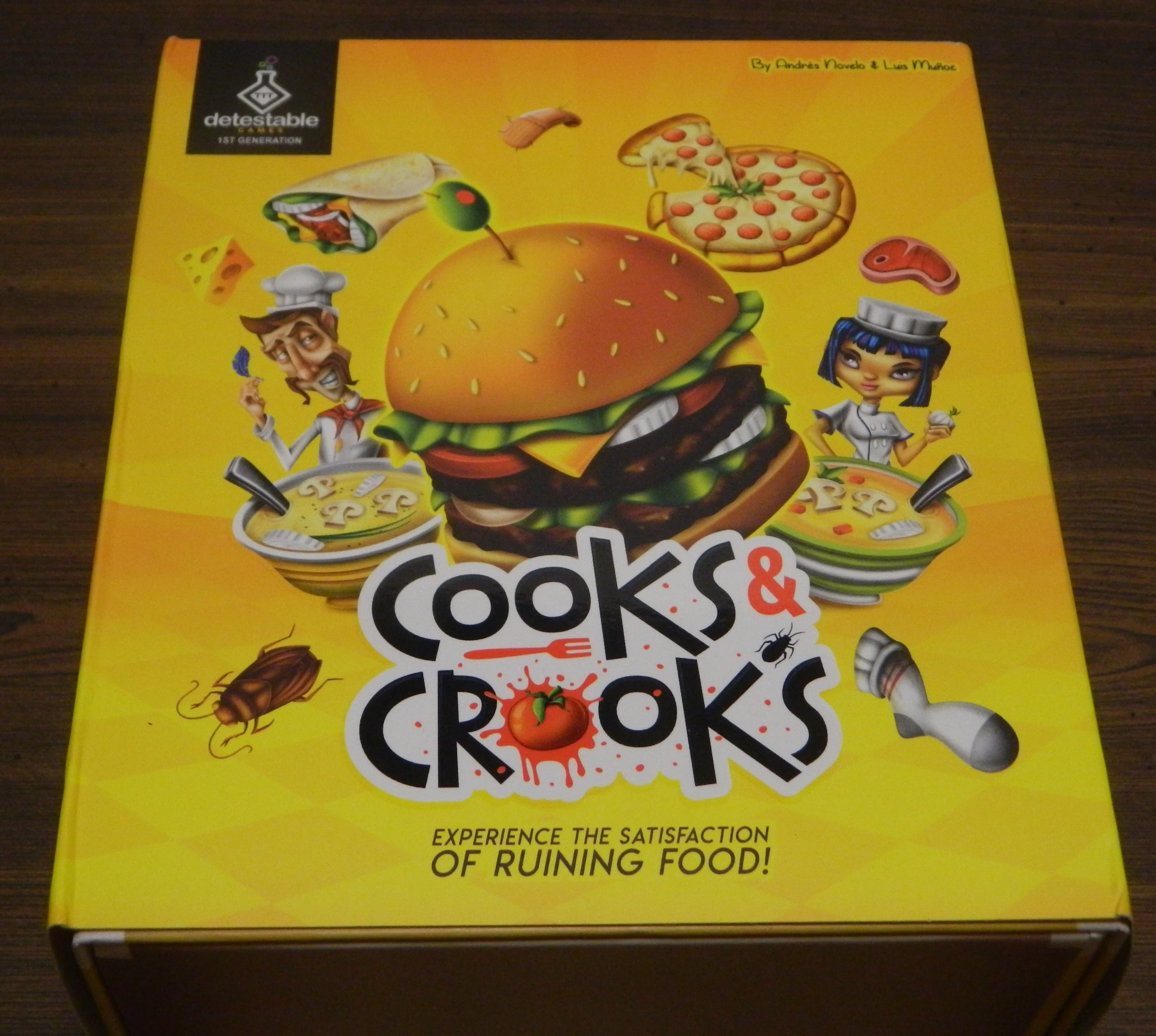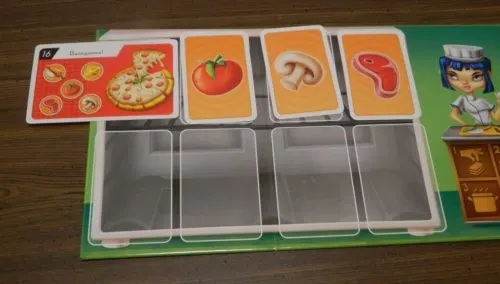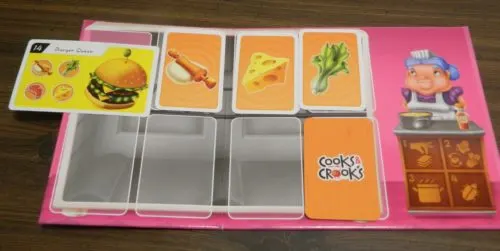In Cooks & Crooks you play as a chef that has just been selected to join a competitive cooking show. Chefs from all over the world have gathered to try and make the best dishes for the judges. While many contestants are honorable, the show is more than willing to accept chefs that are willing to commit some friendly sabotage on the other chefs. Do you have the skill and questionable morals needed to come out on top in the cooking competition? When I first saw Cooks & Crooks I was intrigued. I have always been a fan of card games where the objective is to acquire different sets of cards. In addition Cooks & Crooks appeared to have some interesting twists on the formula as you can sabotage the competition. Add in the cooking theme and I was excited to try out Cooks & Crooks. Cooks & Crooks is not a highly original card game but it does create a fun experience for the whole family.
How to Play Cooks & Crooks
Setup
- Each player chooses an oven.
- Place the turn counter in the middle of the table. Turn the dial to one.
- Shuffle all of the ingredient, trash and radioactive cards into a single deck. Deal three cards to each player. The rest of the cards are placed in a pile face down in the middle of the table.
- Each player looks at the cards they were dealt. They can choose to discard any of the cards they want. All discarded cards are placed next to the draw pile face down to form the discard pile. Each player will then draw the corresponding number of cards from the draw deck.
- The draw pile for the ingredients is then turned face up. The draw pile will remain face up for the rest of the game.
- Separate the dish cards by type. Shuffle each type of dish separately. Place each deck face down in the center of the table.
- Each player chooses a dish and takes the top card from the corresponding deck. The card is placed face up in their oven.
- The player who has eaten most recently will start the game. They will take the Caped Pete standee to indicate they are the first player. Play will continue in a clockwise order.
Playing the Game
A player’s turn consists of four steps. Players can skip any step but the steps must be performed in order. The four steps of a player’s turn are as follows:
- Supply Pantry
- Action
- Prepare Dish
- Sabotage
Supply Pantry
To begin each player’s turn they can choose to discard whichever cards they prefer. All discarded cards are placed face down in the discard pile.
The player then has the option to draw one, two or three cards from the ingredient deck. The player can never have more than seven cards in their hand. Players will draw one card at a time allowing the other players to see what cards they drew. You can choose to quit drawing cards whenever you prefer.
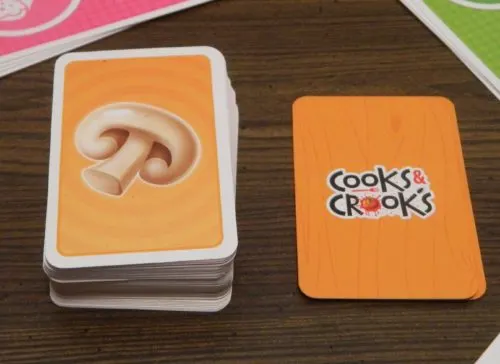
During the supply pantry phase the player will begin by discarding whichever cards they prefer from their hand. The player can then draw up to three cards from the draw pile starting with the mushroom card.
Action
During the action step players can take one of three actions. They can only perform one of the actions or they can choose not to take any of the actions.
Oven Swap
In an oven swap players can take a card from another player’s oven. The card you take will be added to your hand. You will then have to add an ingredient to the other player’s oven from your hand that is one of the ingredients they need to finish their dish.
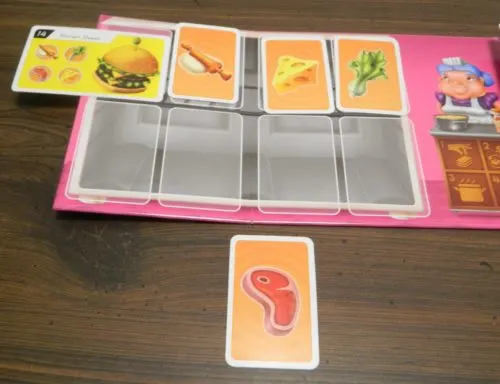
The current player would like to take one of the ingredients from this player’s oven. In exchange for taking one of the cards from their oven, the current player has to add a meat card to their oven.
Players cannot use this action to take a radioactive card that works as a positive ingredient for your dish.
Pantry Raid
The current player chooses another player and takes two of the cards from their hand at random. The player will look at the two cards and will return one of them to the player. The player can keep the other card they took if they give the other player a card from their own hand. The player can also choose to return the second card they drew.
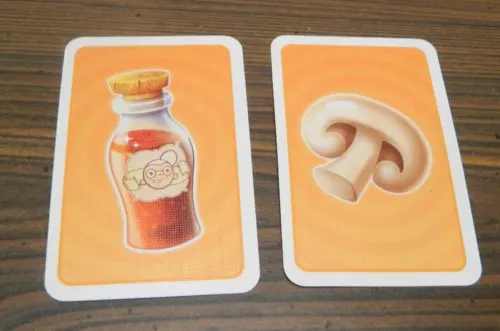
This player has chosen to look at two of the other player’s cards. They will give back one of the cards. They can either give back the other card or keep the card and give the player one of their own cards.
Clean Oven
The player can remove one of the cards from their oven and add it to their hand. If the player’s oven is completely full, they can take two cards from their oven. A player cannot take this action if it would put them over seven cards in their hand.
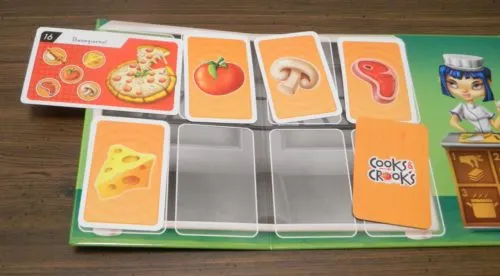
A negative card has been played against this player on a previous turn. They can use the clean oven action to return the negative card to their hand.
Prepare Dish
During this step the player has the option to add up to three ingredient cards to their oven face up (as long as there is enough space left in your oven). You can place three different types of cards into your oven:
- Ingredients requested by your current dish that aren’t already in the oven.
- Mystic Seasoning cards which act as a wild for any missing ingredient. You may only have one Mystic Seasoning card in your oven at a time.
- A radioactive card that matches your current dish. Each radioactive card (green card) is a negative card for all but one dish where it acts as a positive.
A dish will be completed as soon as all of the ingredients shown on the dish card are present in a player’s oven. The player will immediately score the dish. When you score the dish you will flip over all of the face down cards in your oven. The number in the top left corner is the dish’s initial value. You will then subtract points from all of the negative cards placed into your oven.
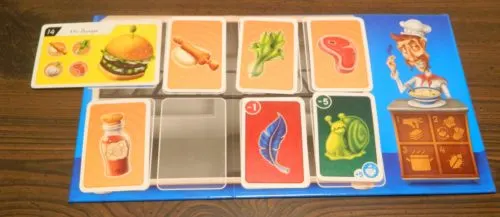
This player has completed the burger as the mystic seasoning is acting as the onion. The player will score 14 points for completing the burger. They will lose six points from the feather and the snail. They will score a total of eight points.
If a player has a radioactive card in their oven that matches the dish’s type, they will add five points to their score instead of subtracting the points.
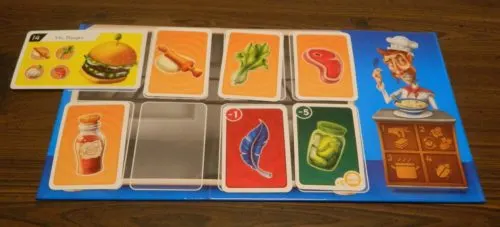
This player will score points as follows: 14 points for completing the burger, -1 point for the feather, and +5 for the pickles. The player will score a total of 18 points.
The player will record the points they scored on the scorepad. The player will remove the dish card from their oven and place it in front of themselves. All other cards placed in the oven are discarded. The player will then select a new dish to complete. Players may not select a dish type they have already completed.
Sabotage
Players can choose one trash (red) or radioactive (green) card and place it face down in another player’s oven. If a player’s oven is already full, a player cannot add another card to the oven.
After the sabotage step, play passes to the next player clockwise.
End of Round
Once all of the players have had their turn, the round ends. The turn counter is increased by one and the game continues.
The sixth round is the last round in the game. If a player finishes a dish in the last round, the dish is scored as normal. The player can also close their oven preventing the other players from sabotaging them.
If a player does not complete a dish in the last round, they will conduct partial scoring. An unfinished dish will score two points for each correct ingredient and proper radioactive card placed in the oven. The player will lose one point for every negative card.
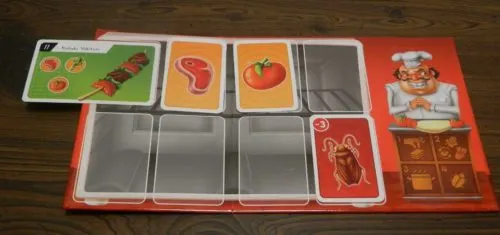
This player was unable to complete the dish in the final round. They will score four points for the ingredients and negative one point for the negative card.
Winning the Game
After all final scoring is completed, players will compare their final scores. The player who scored the most points wins the game. If there is a tie, compare the number of ingredients required for the dishes the players completed. The player who used the most ingredients will win the game.
Team Mode
Instead of playing as individuals, players can play as teams of two. Each player will have their own oven. Each player will take their own turn with teammates alternating turns with the other team. At the end of the game players will combine their scores to get a team total. The team that scores the most points wins the game.
The one change to the gameplay is that there is an additional action that a player can take during the action step. The player can also choose to trade with their partner. If they choose this action they will trade one card from their hand face down with their teammate. The player can either keep this secret from the other team or tell their teammate what they are trading.
2-Player Game
The two player game is the same as the normal game with four changes:
- The second player will be dealt one additional card at the beginning of the game.
- Players can keep up to eight cards in their hand.
- Players can draw up to four cards in the Supply Pantry step.
- Players can play two trash or radioactive cards during the sabotage step.
My Thoughts on Cooks & Crooks
At its heart Cooks & Crooks feels like your typical card game, but at the same time feels different as well. It kind of feels like the next evolution of your typical mass market card game. The core mechanics are pretty similar to a lot of card games. The objective of the game is to complete various dishes in order to score points. You accomplish this by drawing, playing, and discarding cards. The goal is to acquire the ingredients needed by your current dish and adding them to your oven. Once you add all of the necessary ingredients to your oven you will score points and then start work on your next dish.
The card mechanics might not be highly original, but I still really enjoyed them. If I were to explain the mechanics it feels like they took a traditional card game and added a few more mechanics on top to add a little depth. Nothing about these mechanics are revolutionary, but they make for a fun game. The thing I like about the card mechanics is that they do a good job creating a game that the whole family can enjoy. Cooks & Crooks may be a little more difficult than your traditional card game, but it is still quite accessible. The game takes just a couple minutes to explain as all of the mechanics are pretty self explanatory. Even people who don’t play a lot of card/board games shouldn’t have any problems playing the game. Despite the game being pretty simple there is enough strategy to the game to keep most players interested.
Due to being so easy to play, Cooks & Crooks plays pretty quickly. I would say most games will probably take around 30 minutes to play. I see this as both a positive and negative. On the positive side this makes Cooks & Crooks a perfect filler card game. The game is the perfect length if you don’t have a lot of time or need a break from longer games. The games are also short enough that you can play a couple games in a row. For the most part I like the shorter length. The one problem is that the game seems to end too shortly. The game only has six rounds which doesn’t seem to be enough in my opinion. Most players will be lucky to complete two or three dishes in that many rounds. Really unlucky players may only be able to complete one. I think Cooks & Crooks would have benefited from being a couple rounds longer.
In addition to the card mechanics Cooks & Crooks has some take that mechanics. I have played quite a few games with take that mechanics and yet I have never seen any quite like Cooks & Crooks. The game has some of the “nicest” take that mechanics that I have ever seen. There are several different ways you can mess with other players. While there is no recourse for a player playing a negative card against you, most of the take that mechanics have things built in to mitigate the damage. For example if you take one of the cards from a player’s oven you must give them another card that they need. If you look at two cards from another player’s hand and take one of them, you have to give them one of your cards. These don’t totally offset a player messing with you, but it does limit the damage they would normally do. In a game where you are chefs competing on a cooking TV show, I have to say that the contestants are quite polite while messing with each another.
Long term readers of Geeky Hobbies will know that I have always had some mixed feelings towards take that mechanics. I don’t mind take that mechanics, but in a lot of games they end up impacting the game too much as players have no way of preventing a player from messing with them. I thought the rules that mitigate some of the damage done by the take that mechanics were quite clever. For example you can take an ingredient from a player’s oven, but you have to give them another ingredient that they need. If you end up taking an ingredient that the other player doesn’t have another copy of, this could hurt them quite a bit. At the same time they could have another copy of the ingredient you took, and you inadvertently just gave them the last ingredient they needed. I really liked these little tweaks to the formula and I think they could persuade people who normally hate take that mechanics to give Cooks & Crooks a chance.
The one area where you can mess with someone without immediate recourse is playing trash/radioactive cards in a player’s oven. Outside of wasting your action step on a future turn, you will lose points for each negative card played against you. Players can easily gang up on a player (likely the player in first) and load their oven with trash. This will make it harder to complete a dish or make the dish worth considerably less. This is somewhat kept in check as you can only play one negative card each turn. Therefore one player won’t be able to load your oven up with negative cards by themselves. In order to get truly swamped with cards, several players will have to target the same player.
While on the topic of negative cards, they do add some luck to the game. Negative cards can be valuable in hurting other players. They also waste spots in your hand that could have been used for cards to help you complete your dish. You can only use one negative card each turn so there is no point in having more than a couple of them at any given time. Players who are unfortunate though might end up drawing a lot of negative cards instead of cards they need to complete their current dish. If you are stuck in this situation you will be at a huge disadvantage in the game as it will be much harder to score dishes yourself.
At first it might not seem like much but having the draw pile face up actually adds another mechanic to the game. Most players probably won’t put too much thought into it, but having the draw pile face up adds a memory mechanic to the game. Outside of the cards that a player is given at the beginning of the game and cards they trade with the other players, you can theoretically keep track of what cards another player has in their hand. Every time a player draws a card all of the other players will be able to see it. Most players won’t remember all of the cards that other players have, but paying attention to what cards other players draw can inform decisions you make in the game. While I am not a huge fan of memory mechanics, I found this mechanic to be clever. Just by having the draw pile face up allows players to gain additional information if they can remember what cards the other players have drawn. Players can ignore the memory mechanic if they want, but players who can somewhat remember what cards the other players have drawn will have an advantage in the game.
I am going to wrap up by talking about the components. I have to say that I really liked Cooks & Crooks’ components. This was mostly due to the game’s artwork. I found the artwork to be fantastic as it brings a lot of character to the game. Cooks & Crooks actually does a really good job utilizing the food/cooking theme. The card layouts are also really well done as they only rely on images so the components are language independent. The quality of the components are solid as well. This is all wrapped up by the box which is clever. The box is designed like an oven with two magnets holding it shut. To open the box you pull out the doors and it feels like you are opening an oven. This has absolutely no impact on the actual gameplay, but I thought it was a really nice touch.
Should You Buy Cooks & Crooks?
Cooks & Crooks may not be a revolutionary card game, but it does a good job creating a card game that the whole family can enjoy. The game is quite easy to play where children and people that don’t play a lot of card games should have no problem playing the game. It might be simple, but there is still enough strategy under the surface to keep players interested. This leads to the game playing pretty quickly even though I think the game could have benefited from being a couple rounds longer. The card mechanics feel a lot like a set collecting game but different as well. Cooks & Crooks also does a really good job with the take that mechanics as you usually have to give something back whenever you take something. It is still possible for players to gang up on another player though. When you add in the great components it is hard not to have fun with Cooks & Crooks. There may be some better and more original card games, but it is hard to go wrong with Cooks & Crooks.
If you don’t really like simpler card games or card games in general, I don’t think you will enjoy Cooks & Crooks. If you are looking for a simpler card game that the whole family can enjoy though, I think you could have quite a bit of fun with Cooks & Crooks.
If you would like to purchase Cooks & Crooks you can find it online: eBay

